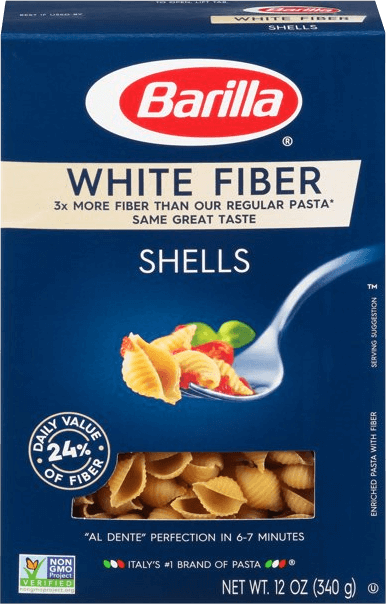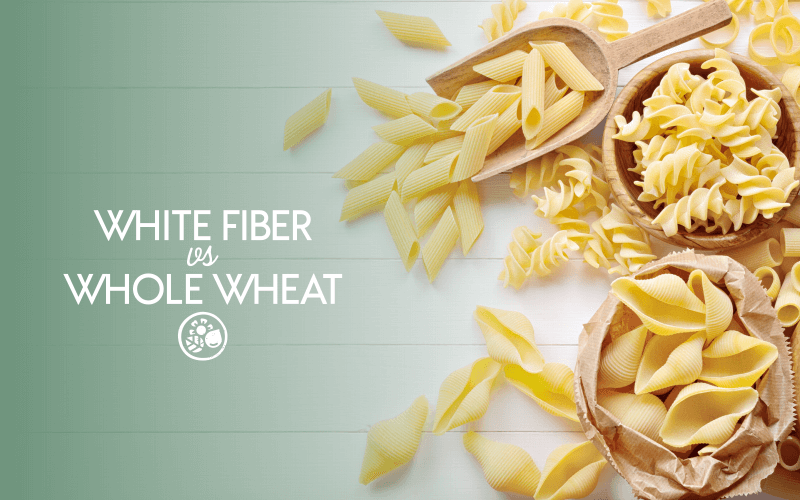As we’ve gone over in previous posts, there’s no shortage of alternative pastas on the market — one of which being Barilla’s brand of white fiber pasta. In this post we’ll be comparing white fiber pasta vs whole wheat pasta to see how they stack up, both nutritionally as well as taste.
In short, the main difference between white fiber pasta vs whole wheat pasta is that the white fiber variety has less nutritional content, but tastes more like regular pasta. Whole wheat pasta has more fiber, more protein, less carbohydrates, and more vitamins & minerals. However, whole wheat pasta has more of a grainy taste and texture.
Let’s compare the two in more detail.
White Fiber Pasta

White fiber pasta is a branded variety of pasta made by Barilla. The idea behind white fiber pasta is that it’s meant to be an alternative to traditional “white” pasta (hence the name) that has the same taste and consistency, but with more fiber added.
Barilla is not the only brand of fiber-added pastas though. There are also other varieties widely available as well, such as Ronzoni’s “Smart Taste” pasta:

Other pasta varieties — such as whole wheat pasta — offer more fiber and nutritional content than regular pastas do, but a common complaint about whole wheat pasta is that it tends to have a stiff, grainy texture comparatively.
White fiber pasta seeks to bring together the best of both worlds by maintaining the traditional taste and texture of regular pasta, but while offering some of the nutritional benefits of whole wheat varieties.
Whole Wheat Pasta

Whole wheat pasta is pasta that is made using whole grain durum wheat flour, as opposed to traditional “white” pastas which use a refined flour.
Since whole wheat pasta uses the entire grain — as opposed to white pasta, which uses a refined flour — whole wheat pasta tends to contain more fiber, vitamins and minerals than traditional varieties, making it a more attractive option for those seeking to eat healthier.
The downside of whole wheat pasta, however, is that it can have a stiff and grainy texture, making it a less appealing option for those prioritizing taste over nutritional content.
White Fiber Pasta VS Whole Wheat Pasta
Let’s have a look at some of the differences between white fiber pasta vs whole wheat pasta, starting with nutritional contents.
Nutrition Facts
The table below compares the nutrition facts of Barilla’s brand of white fiber pasta with their brand of whole grain pasta:
| Item | White Fiber Pasta | Whole Wheat Pasta |
| Serving Size | 2 oz | 2 oz |
| Calories | 180 | 180 |
| Total Fat | 1 g | 1.5 g |
| Cholesterol | 0 mg | 0 mg |
| Sodium | 0 mg | 0 mg |
| Carbohydrate | 43 g | 39 g |
| Dietary Fiber | 6 g | 7 g |
| Soluble Fiber | 1 g | 2 g |
| Insoluble Fiber | 6 g | 5 g |
| Sugar | 1 g | 1 g |
| Protein | 6 g | 8 g |
The data in the table above was collected from the nutrition facts labels of each product, linked in the item names. Let’s examine some of the differences between the two.
White Fiber Pasta Has Less Fat
If you’re seeking to limit your intake of fat then the white fiber variety of pasta holds the edge over whole wheat, clocking in at 1 g per 2 oz serving versus the 1.5 g found in a similar serving size of whole wheat pasta.
A half of a gram of fat may not seem like much at this scale, but it equates to whole wheat pasta containing 50% more fat than white fiber pasta.
These fat grams can add up pretty quickly if you’re someone who likes to eat a lot of pasta.
Whole Wheat Pasta Has Less Carbs
One advantage whole wheat pasta has over white fiber pasta is that it contains slightly less carbohydrates per serving.
Although each pasta is equal in calories, there are some slight discrepancies in macronutrients between the two. Whole wheat pasta having more fat and more protein also means that it has much less carbohydrates — making it a slightly better option for those seeking to limit their intake of carbohydrates.
What’s more, not only does whole wheat pasta have less carbohydrates, but it also has less net carbohydrates as well — the carbohydrate grams that remain when you subtract the grams of fiber.
Net carbohydrates are often regarded as the true carb count, as fiber is indigestible and doesn’t have the same insulinogenic effect as other types of carbs. [source]
Whole Wheat Pasta Has More Fiber
The most surprising discovery when comparing white fiber pasta vs whole wheat pasta is that the whole wheat variety actually contains more fiber per serving.
This may come as a surprise to some, seeing as how pasta brands (such as Barilla and Ronzoni) have marketed the product as a fiber-rich alternative.
This may be true when compared to traditional pastas, but when it comes to whole wheat pasta, it falls short of the mark.
Not only does whole wheat pasta have more fiber, but it also has twice as much soluble fiber. However, white fiber pasta does have slightly more insoluble fiber.
Whole Wheat Pasta Has More Protein
Another advantage whole wheat pasta has over white fiber pasta is that it contains roughly 20% more protein.
Protein contains amino acids that serve many functions in the body, such as aiding in the repair of muscle tissue and ligaments, among other things.
For those who eat a diet consisting primarily of plant-based foods (such as pasta,) protein can come at a premium. If getting more protein in your diet is of concern to you then you’ll be better off reaching for the box of whole wheat pasta.
Vitamins & Minerals
The real benefit of whole wheat pasta starts to reveal itself in the form of vitamins and minerals.
Seeing as how whole wheat pasta is made from the entire grain, a single serving contains:
- Calcium (2% DV)
- Iron (10% DV)
- Potassium (6% DV)
- Thiamin (40% DV)
- Riboflavin (25% DV)
- Niacin (45% DV)
- Folate (20% DV)
- Phosphorus (20% DV)
- Magnesium (15% DV)
- Zinc (20% DV)
- Manganese (70% DV)
By comparison, a similar serving size of white fiber pasta contains:
- Calcium (2% DV)
- Iron (10% DV)
- Thiamin (35% DV)
- Riboflavin (15% DV)
- Niacin (35% DV)
- Folate (30% DV)
In short, white fiber pasta has less potassium, thiamin, riboflavin, phosphorus, magnesium, zinc and manganese — a stark contrast to whole wheat pasta.
White fiber pasta does, however, contain more folate.
Whole Wheat Pasta Has Less Ingredients
Finally, if you’re someone who seeks to consume a minimally-processed diet, the better option would be whole wheat pasta, as it contains less ingredients.
According to the label, the only ingredient in whole wheat pasta is:
- Whole grain durum wheat flour
Comparatively, white fiber pasta contains:
- Semolina (wheat)
- Durum wheat flour
- Whole durum wheat flour
- Resistant corn starch
This means that whole wheat pasta is more of a whole food than white fiber pasta is.
Differences In Taste
Arguably the biggest difference between white fiber pasta vs whole wheat pasta is the taste.
By now we have established that whole wheat pasta contains more nutritional value. However, nutrition facts may not be the only factor in your decision.
Whole wheat pasta is notorious for its stiff, grainy texture. This can be especially problematic when making various meals and dishes that require pasta, as using whole wheat pasta can ruin it.
Whole wheat pasta is best when eaten alone, with sauce and other toppings, when trying to eat healthy.
What People Are Saying
White fiber pasta is meant to provide some of the nutritional benefits of whole wheat pasta, but without straying too far from the texture, taste, and firmness of regular pasta.
Does it accomplish this, though? Let’s hear what some customers have to say:
Love Barilla White Fiber pasta! It cooks and tastes just like regular pasta with a bunch more fiber.
A reviewer on Walmart.com [source]
Likewise, another reviewer had positive feedback:
[…] truly does cook and taste like traditional white pasta. I use the shells in my homemade veggie soup.
A reviewer on Walmart.com [source]
Although feedback is scarce at the time of this writing, it appears as if white fiber pasta really does accomplish its mission of maintaining the consistency of regular pasta, but while adding in some fiber.
The Takeaway
In conclusion, it’s safe to say that the comparison between white fiber pasta vs whole wheat pasta boils down (pun intended) to personal preference.
If you’re seeking to optimize every calorie and reap as much nutrition from your diet as possible, then whole wheat pasta would be the better option.
If flavor and texture is equally important, then white fiber pasta can provide you with nearly as much fiber as the whole wheat variety, but while tasting more like regular pasta.
Healthy pasta alternatives do not stop here though. Those seeking the healthiest options can turn to legume-based pasta products — such as red lentil pasta — for even more nutritional bang for your buck.

